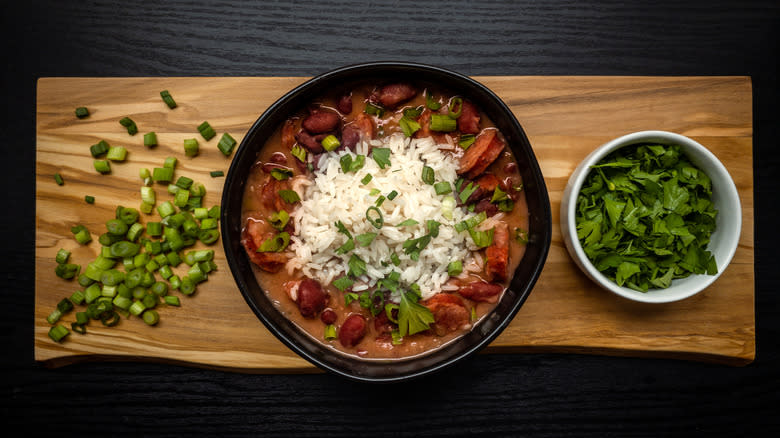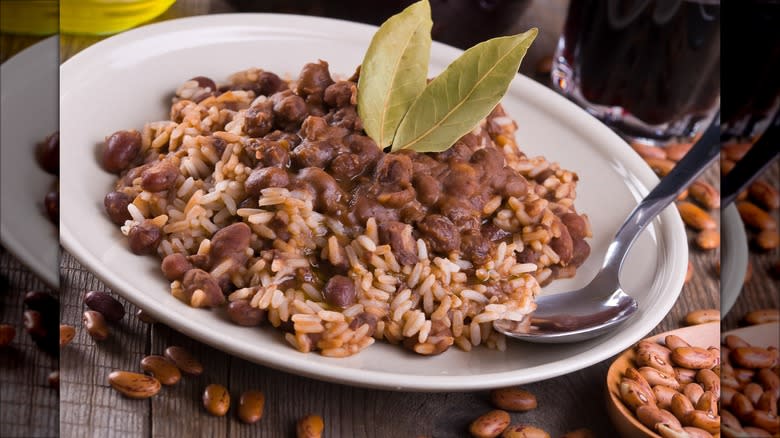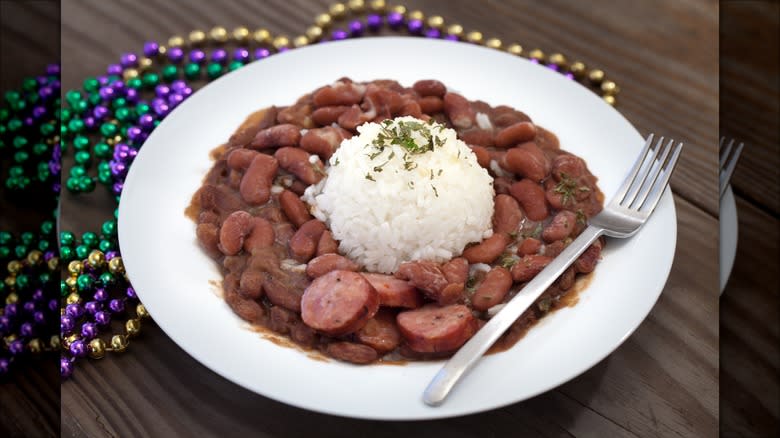How Red Beans And Rice Became A Staple For Mardi Gras And New Orleans Culture

There are plenty of famous New Orleans dishes that you should try when visiting the historic city. You can grab a po'boy or muffuletta for lunch and satisfy your sweet tooth with a beignet for dessert. One of those iconic dishes is a little more simplistic: Red beans and rice. The stew-like dish is often served with meat mixed in for some added protein. And while it can be eaten any time, it's traditionally enjoyed on Monday nights.
There's no definitive story behind the tradition, and no one is named the inventor of it, but it likely stemmed out of convenience. Before washing machines cleaned clothes quickly, Creole women would have to wash the household's garments by hand. Monday was traditionally laundry day in households; it's an old tradition that honors Sunday as a rest day but still allows for clean clothes to be ready early in the week.
Since washing an entire household's clothes by hand was time-consuming, women needed a quick and easy meal to cook. Red beans and rice could simmer on the stovetop all day, making for an easy-to-serve dish when dinnertime came around. The dish required minimal stirring throughout the day, so you could set it on the stovetop and leave it for a while — like an early crock pot concept. The tradition became so commonplace in New Orleans that even a few pre-Mardi Gras floats honor the red beans.
Read more: French Cooking Tricks You Need In Your Life
Red Beans Are Honored In A Parade

The Monday before Mardi Gras — which always starts on a Tuesday — is called "Lundi Gras." Typically, two parades take place to honor (and coincide with) the meal traditionally eaten on Mondays. The Red Beans Parade — run by the Krewe of Red Beans — marches through the streets. The organization supports people in New Orleans and raises awareness of the culture, history, and — of course — Mardi Gras through parade participation. It participates in Lundi Gras with a parade float covered in dried beans. Members of the Krewe who walk in the parade also adorn their outfits with dried beans. It converges with another group, the Dead Beans Parade, which honors afterlife and death with its bean-themed float and participant outfits.
Restaurants in the New Orleans area honor the tradition by regularly serving up the dish. Some places will even offer specials where diners can grab a complimentary plate of red beans and rice with any other purchase on a Monday. It can be eaten alongside other iconic New Orleans entrees or enjoyed on its own. But of course, you can always cook up your own while working on chores.
How To Upgrade The Dish

There are a few ways to enhance the taste of red beans and rice. If you enjoy some roast meat for dinner on Sunday night, don't throw out those leftovers. You can bulk up the dish by tossing the extra meat in the pot along with the beans and rice, allowing the flavors from the added protein to absorb into the other ingredients. You can also cook up some vegetables to mix in; onions, celery, bell peppers, and tomatoes are common additions.
Alternatively, cook the beans and rice in broth or stock rather than water. Or, simply toss in bones from a previous dinner to make your own while the dish simmers. And, of course, don't forget to season the pot. You can make your own creole seasoning mix using a blend of ingredients like paprika, cayenne pepper, and garlic powder.
Though the meal of red beans and rice may have humble origins, the dish has woven itself into an essential part of New Orleans culture over the years. The next time you visit the city — or catch yourself craving some Cajun food — go ahead and grab a serving of the simple but delicious dish.
Read the original article on Daily Meal.

